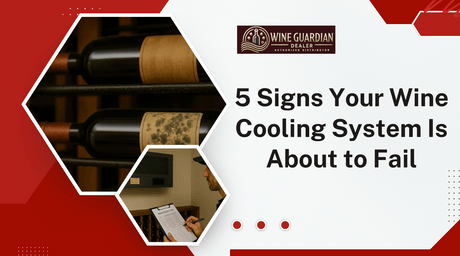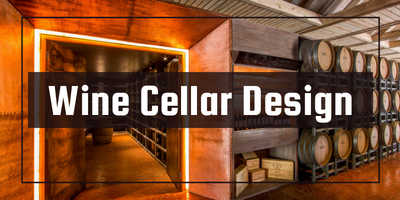
5 Signs Your Wine Cooling System Is About to Fail
Don’t wait for a costly surprise. Wine Guardian Dealer breaks down the top 5 signs your wine cooling system may be failing — and how to fix it before damage...
Jim Hopper
In Stock & Ready to Ship – Order Your Wine Cooling System Today!
Free Wine Cellar Expert Consultation | 📞 Call 1-800-260-1712
Start with a free expert consult—cooling system sizing, racking options, and no upsells.

Build your dream wine cellar—without costly mistakes or guesswork.
By Jim Hopper, Wine Cooling Expert
Living in a warm climate and have a passion for collecting wine? You've got exquisite taste—but your beloved bottles could be at risk.
Wine storage in hot climates presents unique hurdles. High outside temperatures, dry air, and uninsulated rooms can quickly push your wine past its comfort zone. Without the right setup, your wine could age prematurely—or worse, spoil altogether. Installing air conditioning can help maintain a stable and comfortable environment, ensuring your wine stays within the ideal temperature range.
Ambient temperature plays a crucial role in wine storage. Exposure to elevated ambient temperatures during storage and shipping can compromise the wine's integrity, making it essential to control and monitor these conditions.
This guide will walk you through:
Let’s safeguard your wine the right way — no matter where you live. For long-term aging strategies and preservation tips, explore our full Wine Aging and Preservation: Protecting Your Collection for the Next 30 Years.

Wine is a living product. It reacts to its environment—especially temperature. Just like food, wine spoils if exposed to too much heat. Heat damage can make wine taste unpleasantly sour and jammy, ruining its intended flavor profile and leading to wine heat damage.
Once temperatures rise above 70–75°F, your wine can begin to age rapidly. Leave it at 80°F or higher for too long, and it could permanently lose its aroma, balance, and flavor. Improper storage can result in what some call a 'bad bottle,' where prolonged exposure to excessive heat deteriorates the wine's quality. Ideally, wine should be stored between 45°F and 65°F to maintain its quality.
|
Temperature |
Result |
|---|---|
|
55°F (Ideal) |
Wine ages slowly and evenly |
|
65°F–75°F |
Wine matures faster than intended |
|
75°F+ |
Corks can loosen, wine oxidizes |
|
80°F+ |
Chemical spoilage, flavor breakdown, label damage |
Wine also needs humidity control. Hot climates are often dry, which causes corks to shrink. When that happens, oxygen enters the bottle—ruining the wine. Humidity levels between 50 percent and 80 percent are generally safe for wine storage, ensuring corks remain intact and effective.
📘 Related: Why Temperature Control Is Critical for Wine Storage

If you’re in a place like Florida, Arizona, Texas, or Southern California, storing wine presents unique challenges:
Even short periods of improper storage can degrade wine quality. That’s why purpose-built wine storage systems matter more in hot climates. Investing in a dedicated wine cellar or cooling system can help maintain the ideal storage temperature and humidity levels, ensuring your wine collection remains in optimal condition. Additionally, using UV-protective coatings on windows and doors can minimize the effects of direct sunlight, further safeguarding your wines from heat damage.

No matter where your wine is stored, here’s how to protect it: Store your wine bottles sideways to prevent cork drying and ensure a proper seal. Serving wines at the correct temperature is also crucial to enhance their flavors and overall enjoyment.
When you buy wine, make sure to choose stores that maintain proper temperature control to ensure the best quality. Additionally, making informed decisions when you buy wines for aging or collection is important, as factors like storage conditions can significantly impact their maturation. Improper storage conditions can damage wine, with sustained temperatures above 70 degrees leading to permanent changes in flavor.
Avoid hot spots like kitchens, garages, or laundry rooms without insulation. These areas are prone to temperature fluctuations and can expose your wine collection to heat damage and humidity issues, which can lead to premature aging and spoilage.
Choosing a location suitable for long term storage is crucial to maintaining the quality and aging potential of your wine.
Better locations include:
For those serious about their wine collection, investing in a dedicated wine cellar or a professionally designed storage area can ensure optimal conditions for long-term aging. This can include features like UV-protective coatings on windows to prevent ultraviolet light damage, as well as advanced temperature and humidity control systems to maintain the ideal storage temperature and humidity levels. 📘 Best Places to Build a Wine Cellar in Your Home
Heat from outside can penetrate through walls, ceilings, and even floors. Insulating your wine storage room properly is key. Additionally, keep wines away from light to preserve their quality and prevent chemical degeneration.
Proper insulation helps protect red wine from heat damage, ensuring that high temperatures do not negatively affect its flavor and quality.
📘 Learn more: Wine Cellar Insulation Guide
Standard HVAC or portable A/C units aren’t designed to hold a steady 55°F—or protect wine over the long haul. While air conditioning can help maintain the correct temperature for wine storage, you need a wine cellar cooling system engineered for this exact purpose.
🔹 Wine Guardian Sentinel Series
Hot climates are often dry. If your relative humidity falls below 60%, corks dry out and your wine becomes vulnerable to oxidation. This is a critical aspect of wine storage that can often be overlooked, but maintaining proper humidity levels is essential for preserving the quality and longevity of your wine collection. In addition to cork protection, proper humidity levels help prevent the wine from becoming overly concentrated due to evaporation, which can alter its intended flavor profile.
Maintaining proper humidity levels is particularly important for red wines, as it helps ensure they retain their intended flavor and freshness.
By investing in a reliable humidification system, you can safeguard your wine collection against the adverse effects of a dry climate, ensuring that each bottle remains as the winemaker intended, ready to be enjoyed at its peak.
Don’t just set it and forget it. Use a digital monitor—or choose a Wine Guardian system with Wi-Fi monitoring and alerts.
Monitor:
“Our Phoenix home made wine storage impossible until we installed a split system from Wine Guardian. It’s 110°F outside, and our cellar holds at 55°F like clockwork.”
— Jared H., Arizona
“We store wine in a converted Florida garage. Without Wine Guardian’s ducted cooling and humidifier, we’d have lost half our bottles by now. Incredible difference!”
— Trina R., Sarasota, FL
“I used a wine fridge, but it couldn’t handle summer heat in California. Upgraded to a Wine Guardian system with built-in alerts—now I sleep better at night.”
— Luis M., Palm Springs, CA
Don’t let the climate ruin your collection. Whether you live in the desert, tropics, or just a home with sun exposure, we’ll help you build a wine storage system that keeps your wine perfectly preserved.
👉 Shop Wine Guardian Cooling Systems
Explore ducted, split, and wall-mounted systems for challenging spaces.
📞 Call 1 (800) 260-1712 for a FREE consultation
Our wine storage experts will help you design a system that works with your space, climate, and collection goals.
No. Room temps fluctuate too much, especially in hot regions. Even short spikes over 75°F can ruin wine.
Yes—with proper insulation, vapor barrier, and a Wine Guardian cooling system, garages make great wine rooms.
If your climate is dry (like Arizona, Utah, or inland California), yes. It prevents cork shrinkage and keeps humidity balanced.
Always aim for a consistent 55°F with minimal fluctuation.
Not for serious aging. Wine fridges can overheat and don’t control humidity. A wine cellar system is much more reliable.
🛒Shop our most-loved Wine Guardian cooling systems today.
🛠️Protect your wine with the most trusted systems on the market.
❤️Tested, reviewed, and loved by serious collectors like you.